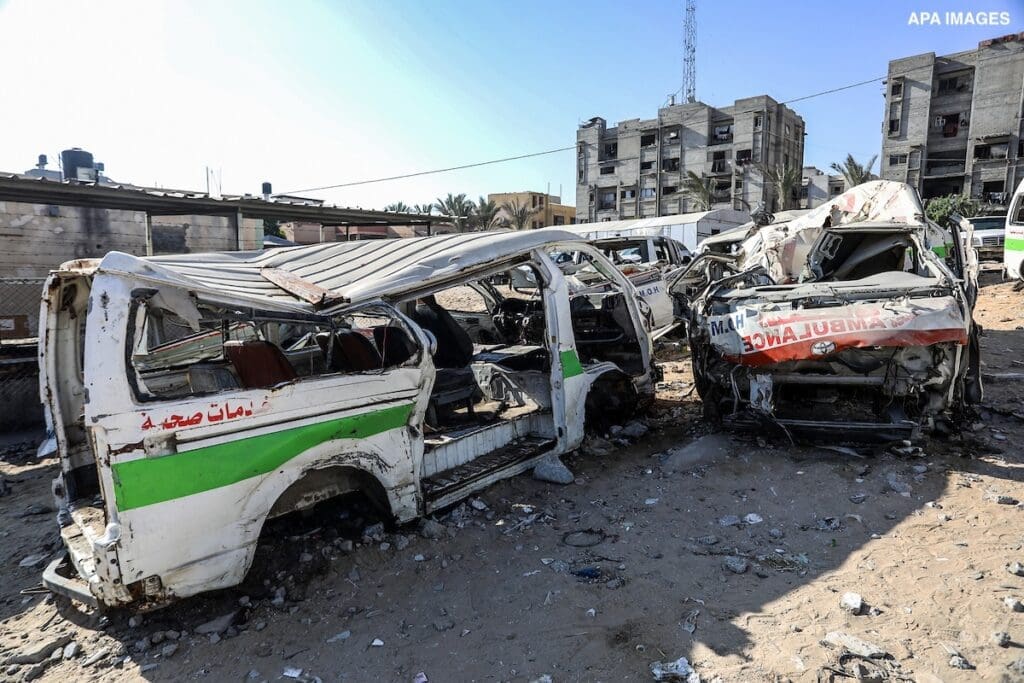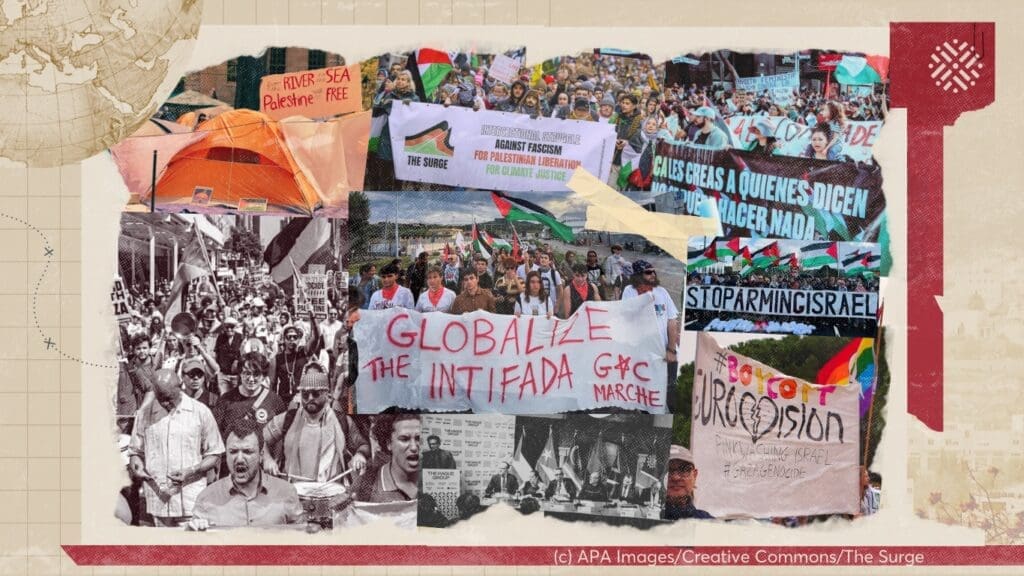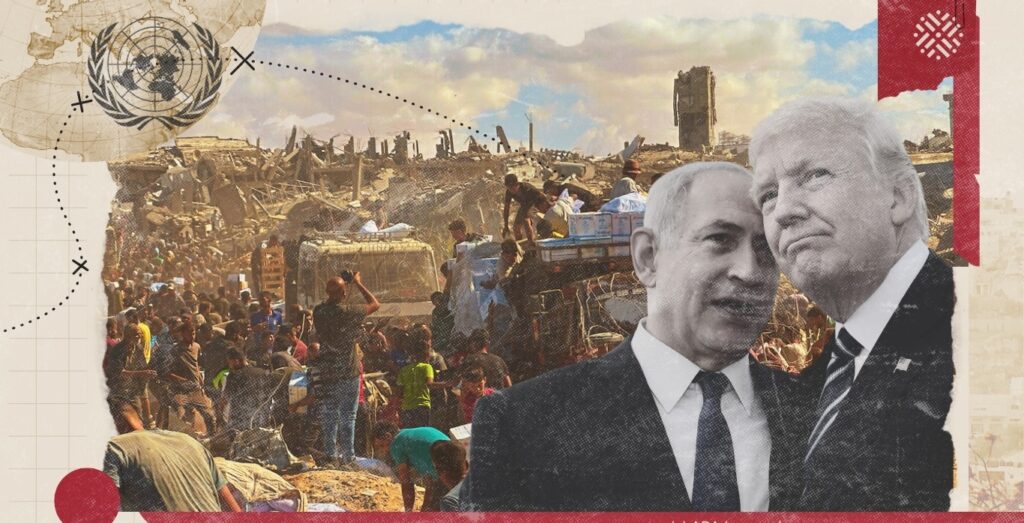- Topics
-
Topics
See our analysis on civil society and how it shapes culture, politics, and policies
Read our insights on the shifting political landscape and what it means for Palestine
Learn more about the policies and practices shaping the Palestinian economy
Strengthen your understanding of the unique conditions for Palestinian refugees across the Middle East
-
- Analysis
-
Analysis
In-depth analysis on existing or potential policies that impact possibilities for Palestinian liberation.
Insights and perspectives on social, political, and economic questions related to Palestine and Palestinians globally.
Concise analysis into a specific policy, its background and implications.
Commentary that brings together insights from multiple analysts.
Compilations of past Al-Shabaka works surrounding a specific theme.
Longer-form, ad hoc projects that seek to confront research questions outside the scope of our regular analysis.
A policy-driven research initiative by Al-Shabaka: The Palestinian Policy Network.
Our monthly webinar series that brings together Palestinian experts.
Featured
This policy brief introduces de-healthification as a framework for understanding Israel’s systematic destruction of Palestinian healthcare infrastructure, particularly in Gaza. Rather than viewing the collapse of Gaza’s health system as a secondary outcome of the genocide, the brief argues that it is the product of long-standing policies of blockade, occupation, and structural neglect intended to render Palestinian life unhealable and perishable. By tracing the historical evolution of de-healthification, this brief argues that naming the process is essential for accountability. Because intent is revealed through patterns of destruction rather than explicit declarations, the framework of de-healthification equips policymakers, legal bodies, and advocates to identify healthcare destruction and denial as a core mechanism of settler-colonial control. Layth Malhis· Jan 11, 2026The global reckoning that followed October 7, 2023, marked a profound rupture in how Palestine is understood worldwide. The Gaza genocide exposed how Israeli mass violence is not exceptional or reactive, but foundational to the Zionist project. What was once framed as a “conflict” to be managed is now widely recognized as a system of domination to be dismantled. It ushered in a shift away from the technocratic language of peace processes and toward an honest confrontation with the structural realities Palestinians have long named: settler colonialism, apartheid, and the ongoing Nakba. The commentary argues that the Israeli genocidal campaign in Gaza has radicalized the world. When crowds march through global capitals demanding a free Palestine, they simultaneously articulate demands for the abolition of racial capitalism, extractive regimes, climate injustice, and all forms of contemporary fascism. In this moment of radical clarity, Palestine becomes a lens through which the underlying architecture of global domination is laid bare—and through which new horizons of collective freedom emerge.
Layth Malhis· Jan 11, 2026The global reckoning that followed October 7, 2023, marked a profound rupture in how Palestine is understood worldwide. The Gaza genocide exposed how Israeli mass violence is not exceptional or reactive, but foundational to the Zionist project. What was once framed as a “conflict” to be managed is now widely recognized as a system of domination to be dismantled. It ushered in a shift away from the technocratic language of peace processes and toward an honest confrontation with the structural realities Palestinians have long named: settler colonialism, apartheid, and the ongoing Nakba. The commentary argues that the Israeli genocidal campaign in Gaza has radicalized the world. When crowds march through global capitals demanding a free Palestine, they simultaneously articulate demands for the abolition of racial capitalism, extractive regimes, climate injustice, and all forms of contemporary fascism. In this moment of radical clarity, Palestine becomes a lens through which the underlying architecture of global domination is laid bare—and through which new horizons of collective freedom emerge. Tareq Baconi· Dec 21, 2025Inès Abdel Razek and Munir Nuseibah joined Al-Shabaka for a conversation on the politics behind the UNSC resolution, the implementability of the US-Israeli plan, and the scenarios now being advanced for Gaza and for Palestine more broadly.
Tareq Baconi· Dec 21, 2025Inès Abdel Razek and Munir Nuseibah joined Al-Shabaka for a conversation on the politics behind the UNSC resolution, the implementability of the US-Israeli plan, and the scenarios now being advanced for Gaza and for Palestine more broadly.

-
- Resources
- Media & Outreach
- The Network




The Floating Gaza Pier: A Symbol of Future Colonial Plans
On May 17, 2024, the US Central Command (CENTCOM) began operating a temporary floating pier off the coast of Gaza. The pier’s construction was purportedly part of a rapid international response to ensure larger flows of humanitarian and relief aid into Gaza amid Israel’s ongoing genocide and escalating warnings of wide-spreading famine and food insecurity for two million Palestinians. Since the project’s announcement, however, many have expressed skepticism towards the pier’s effectiveness and deep concern regarding the US military’s long-term plans for the pier and its potential role in serving Israeli military and political objectives. Indeed, the arrival of the first humanitarian aid shipment via the pier coincided with Israel’s expansion of its military operation in Rafah and occupation of the Rafah border crossing—the sole crossing to Egypt for Palestinians in Gaza.1
This commentary examines available data related to the pier’s operations, and unpacks the many incentives for its development by key geopolitical players. It positions the pier within Israel’s longer-term strategy for both Gaza and Palestine as whole, using the structure as a window into understanding the regime’s broader regional aims. Temporary or not, this commentary contends that the pier must not be viewed as merely a short-term humanitarian effort, but also as a symbol of the US and Israel’s continued imperial and colonial endeavors.
What is the US Floating Pier?
The floating pier extends for 550 meters into the sea and faces the Netzarim Corridor, where large Israeli military bases and logistical facilities have been established to divide Gaza’s northern and southern regions and entrench a more permanent Israeli presence. Once at full capacity, US and Israeli militaries will reportedly coordinate to allow for roughly 90-150 truckloads of assistance to be transported daily from the pier into Gaza—a far cry from the 500 truckloads required to meet the basic needs of Palestinians, according to UN data. It is worth noting, however, that only around 250 truckloads of aid in total have arrived through the pier since its launch.
The floating pier aligns with the US’s political and military objectives in the region and could signal the start of a continued US military presence in the eastern Mediterranean Sea Share on X
Israeli-approved aid shipments originating from Cyprus are intended to be transported directly from the pier to the shore by international aid organizations, and unloaded and secured in storage facilities before eventually being disbursed. The US administration has repeatedly asserted that its troops operating the pier will not be stationed on Gaza’s soil, but will instead continue to reside on floating US vessels based miles off the shore.
Initial construction and preliminary operation of the pier cost an estimated $230 million, and costs have likely only increased as a result of recurring setbacks. While the pier was allegedly planned to operate for only 90 days, these delays have resulted in an unknown timeline for the project’s duration. Moreover, though the US Agency for International Development (USAID), the World Food Program (WFP), and other international partners are cooperating with the US military to deliver aid through the pier, the United Nations Relief and Works Agency for Palestine Refugees in the Near East (UNRWA) remains excluded from the effort in a clear maneuver by the US to marginalize the agency’s role.
While neighboring Egypt has supposedly expressed concerns over the pier’s use for aid delivery in lieu of pre-existing land crossings, many other actors—including the European Union, individual European states, and the United Arab Emirates (UAE)—have nonetheless welcomed this mission and expressed their readiness to take part. The US-controlled pier, for example, exists alongside and in collaboration with Cyprus’ Amalthea Initiative. Developed in late 2023, the Amalthea plan involves a multi-national European committee (including representatives from Israel) collecting, storing, and inspecting aid in the port of Larnaca, which is then sent to Gaza on vessels accompanied by warships.
The Pier’s Role in US & Israeli Long-Term Planning
To understand the full potential impact of the floating pier, it must be examined beyond its explicit and temporary aims. Below are only a few of ways that the pier feeds into US and Israeli longer-term strategies.
US Political Cover & Emerging Opportunities
Since the beginning of the genocide, the US administration has exploited humanitarian efforts as cover for its political agenda and self-interested policies. For example, the US’s largely ineffective aid airdrops, carried out in cooperation with allied states, were used to sway public perception of its role in the Gaza genocide from that of war mongerer to one of humanitarian provider. The pier is yet another example of this strategy, and is being used to mitigate domestic and foreign pressures arising from accusations of US involvement in Israel’s bombardment, starvation, and obstruction of aid. With presidential elections looming, the Biden administration is desperately trying to whitewash its complicity with a veneer of humanitarian efforts.
The reality, however, is that the floating pier aligns with the US’s political and military objectives in the region and could signal the start of a continued US military presence in the eastern Mediterranean Sea. In establishing such a presence, the US would boost its control over maritime passages amid escalating security tensions in the Red Sea, resulting from Houthi attacks on commercial ships with connections to the Israeli regime or the US. If effective, the pier could also be used as a permanent logistics and military supply line for the recently expanded US military base in the Naqab desert, further establishing a significant and strategic US presence.
In circumventing every land crossing in Gaza, the floating pier likewise bypasses Hamas’s oversight and further marginalizes its governance role in administering aid Share on X
The US private sector is likewise seizing the opportunity to profit off of Palestinian suffering in Gaza. This is most clearly evident by the emergence of the private firm Fogbow. Led by a group of former US military officials, CIA officers, and diplomatic personnel, Fogbow was established in 2022 but its first project is a proposal to lease barges to government agencies for the delivery of humanitarian supplies to Gaza. Fogbow officials have confirmed that they are planning to use the US pier to facilitate aid into Gaza, and some have speculated that the US military may at some point hand over pier operations to the firm. Moreover, the company is currently engaged in intensive talks with notable Palestinian businessmen outside of Gaza, including Bashar Masri, to explore cooperation opportunities for storage and distribution of aid in Gaza. If implemented, Fogbow’s plan could accordingly redefine the economic relationship between Gaza and the West Bank.
Marginalization of Adversaries
US interests are not the only ones served by the floating pier’s operation. Indeed, Israeli media reported in March 2024 that the very concept of the pier was first conceived by Israeli Prime Minister Benjamin Netanyahu back in late October 2023. Despite the US’s role in spearheading the current pier project, it is worth recalling that the Israeli government promoted a similar initiative years ago in the form of a floating island off of Gaza’s coast. Not dissimilar to the current pier, the island was proposed as a means to help facilitate the delivery of humanitarian aid without the use of established land crossings. It should come as no surprise, then, that Israeli officials welcomed the recent US-funded project—including Israeli Defense Minister Yoav Gallant, who stated that the pier would help to “continue the collapse of Hamas’s rule in Gaza.”
It is worth underscoring this point: In circumventing every land crossing in Gaza, the floating pier likewise bypasses Hamas’s oversight and further marginalizes its governance role in administering aid. In doing so, as Gallant suggests, Israel is counting on the pier to expedite the movement’s disempowerment. The same can be said for the role of UNRWA, which remains excluded from the pier project and which Israel has long sought to undermine. The sudden presence and involvement of well-funded organizations like World Central Kitchen and Fogbow, alongside the WFP and USAID, fuel the false notion that UNRWA is replaceable. Egypt, in its role as the primary arbiter of aid into Gaza through the Rafah crossing, is a third actor sidelined by the floating pier; this has only been exacerbated since Israel occupied Rafah, including the crossing, in April 2024.
Such marginalization of key actors helps Israel to lay the groundwork for a reordering of Gaza. Indeed, the pier’s position at the end of the Netzarim Corridor is no coincidence. The Israeli military began construction of the road, also known as Route 749, in October 2023 and completed its reach to the sea in March 2024. Just two months later, the pier was developed and stationed at its finish line. Accordingly, the location of the floating pier at the helm of Israel’s dividing line through Gaza suggests an influential future role for the Israeli army in aid distribution, where the assistance could become a tool for long-term control over Gaza’s population.
This function fits neatly into Israel’s longer-term plans for the territory, which include the complete closure of Rafah crossing, the termination of UNRWA operations, and a reshuffling of local administrative leadership. One known strategy for this latter aspect includes empowering local tribes in Gaza to reproduce the “village league” model, previously implemented in the West Bank during the 1970s. These leagues would manage Gaza’s internal affairs and oversee the distribution of humanitarian aid, under the ultimate auspices of Israel. The approach seeks to create a wave of chaos and internal division that would cement the state of political separation between Gaza and the occupied West Bank.
Netanyahu’s Future: Gaza 2035 and the IMEC
Further details on Israeli plans for the future of Gaza were unveiled in May 2024, with the leaking of Netanyahu’s “Gaza 2035” master plan. In addition to the aforementioned military and governance elements, Gaza 2035 anticipates roping the territory into Israel’s larger plans to streamline its relations across the region through techno-economic development and exploitation of Palestinian natural resources—most notably, Gaza’s gas reserves.
While supposedly temporary in nature, the pier serves as a representation of the US and Israel’s far more grand and insidious plans for Gaza Share on X
One key element of this is the creation of a high-speed rail line that runs through Saudi Arabia and connects passengers to either Gaza and on to Egypt or to Tel Aviv and on to Haifa. Importantly, Haifa serves as the main port for the planned India-Middle East-Europe Economic Corridor (IMEC), designed to compete with the International North-South Transport Corridor (INSTC) that crosses Central Asia. The new IMEC was announced at the 2023 G20 New Delhi Summit and establishes commercial routes and a network of seaports from India to the UAE via the Arabian Sea. The railway outlined in the Gaza 2035 plan would serve as a central land link from the Gulf to the Mediterranean Sea as part of this initiative, in which Israel will play a central role.
For both Israel and the US, the IMEC creates an opportunity to counter Iran and its allies’ influence while also presenting a formidable challenge to China’s Belt and Road Initiative, which has expanded the latter’s influence in the Mediterranean region. Moreover, the IMEC helps to integrate Israel further in the region under the guise of “economic peace” amid a backdrop of increasing momentum to normalize relations between Israel and Saudi Arabia within the framework of the Abraham Accords.
The IMEC has been welcomed with enthusiasm in Israel, and was lauded by Netanyahu as a significant path towards the transformation of Israel into a hub for the global economy and advanced technology developments. For Arab Gulf countries, the project is seen as a preamble to expanding their economic and geopolitical influence. While the events of October 7th and the ongoing genocide in Gaza have supposedly halted the project, with parties involved citing security challenges, Netanyahu’s Gaza 2035 plan signals its quiet advancement.
Conclusion
The floating pier project must therefore be situated within the region’s wider and complex shifting geopolitics. While supposedly temporary in nature, the pier serves as a representation of the US and Israel’s far more grand and insidious plans for Gaza. Within them, it is likely that the pier may act as a vital tool in sustaining the daily lives of Palestinians in Gaza, independent of any Palestinian leadership, and as a means for both the US and Israel to continue to evade political responsibility.
Indeed, the pier represents Israel’s longer-term thinking around a permanent presence in Gaza, and of the role it envisions for Gaza to serve as a key link between Israel and the rest of the region. Though ostensibly a short-term humanitarian tool, this commentary has demonstrated the way in which the pier fits into Israeli plans to sideline its adversaries and deepen alliances, all while offering the US political cover for its continued complicity. Thus, even if the pier itself is dismantled in the near future, as some reports indicate may happen, it undoubtedly remains an indication that the US and Israel are carrying forward at full speed with their strategies for Gaza and for Palestine as a whole, without concern for Palestinians themselves.
Mohammed Al-Hafi
Latest Analysis
De-Healthification: Israel’s Engineered Collapse of Palestinian Life
The World Radicalized by the Gaza Genocide
Legitimizing Genocide: The Israel-Trump Plan and Gaza’s Future
We’re building a network for liberation.
As the only global Palestinian think tank, we’re working hard to respond to rapid developments affecting Palestinians, while remaining committed to shedding light on issues that may otherwise be overlooked.